Our twins sleep 11-12 hours a night. I can’t remember the last time they woke up during the night and required our attention, which is really saying something, because during the first few months I thought that hellish phase would never end, and that I couldn’t possibly survive the months-long period of terrible exhaustion that plagues all parents of newborn multiples. One thing is for sure, though: I will never take sleep for granted again. I cherish every full night of sleep we enjoy now.
Many people (including many parents of twins/multiples younger than ours) have asked us about sleep-training. Understandably, sleep-training is an incredibly common subject of conversation among parents of multiples — a common obsession born of desperation and abject sleep deprivation.
I’ve never been more tired than I was those first few months after the duckies came home from the hospital. I thought I had been tired before — I had pulled all-nighters, worked graveyard shifts and odd hours, struggled to get 6 hours of sleep when I was a single parent working multiple jobs — but I had never felt the kind of prolonged, continual exhaustion we experienced during those first few months. We were both so tired we were hallucinating — seeing phantom trails passing by open doors, thinking we saw babies everywhere. It was scary. Everything hurt. I used to watch commercials for sleep aids on television, sitting on the living room floor in a blurry haze of bone-tired weariness, holding a baby. I would literally weep with envy at the actors on the screen stretched out on acres of luxurious bedding, free to sleep as long as they liked.
So sleep training was a big deal. We talked about it constantly. The books we read all agreed that newborns couldn’t be sleep-trained (not that I was averse to trying, at the time), and for the most part, I think they were right. Newborns just sleep whenever they need to sleep, seemingly without rhyme or reason, without regard for noise or circumstance.
In the beginning, the twins were sleeping in our room at night. Calvin had slept in my room as an infant and toddler (out of necessity, at the time — when Calvin was little he and I lived in a small one-bedroom attic apartment near my college) and I wanted the babies close during the night for feeding. But by the time they were three months old, we were desperate for sleep. Even when both babies slept at the same time, I struggled with insomnia — I simply could not sleep through their hiccups and yips and whimpers. How could I have forgotten how loudly babies sleep?
In any case, when it came time to properly sleep-train the twins, I took a very serious approach. I kept spreadsheets that charted when each twin slept and ate. I read everything I could on the subject. I talked to twin parents who had somehow survived their twins’ infancy (it seemed unfathomable to me at the time — one of my survival mantras was “Other people have survived this. Other people have survived this.”) With that in mind, here are three big mistakes we made with sleep-training (before we learned what worked) followed by my personal step-by-step method for sleep-training twins.
But here is my caveat: this is what worked for us. I understand that all parents are different, and all babies are different, and although I do think these rules are fairly universal, there are some circumstances that might require tweaking your approach — if your baby has serious reflux issues, for example (premature babies often do), or colic, or other health complications. Some parents are also uncomfortable with “crying it out,” even in a modified version. Your mileage may vary.
THREE THINGS WE DID WRONG, IN NO PARTICULAR ORDER:
1. We thought that if we kept the twins up later, they would sleep longer.
Ha! Haha! Oh, we were so naive. In our desperation for sleep, we put the twins to bed later and later, thinking they’d sleep later and longer. Eventually we were putting them to bed at 10 p.m., hoping and praying that they’d at least sleep until 1 or 2.
This did not happen. Here’s what DID happen — they got fussy and overtired, and inevitably fell asleep early, after which we’d attempt to wake them up and/or keep them up, and they wouldn’t sleep longer — if anything, they seemed to wake up MORE. Because they were overtired, and because they weren’t going to bed at their natural bedtime (which, as it turns out, was much earlier, closer to 7 p.m.) the babies’ sleep rhythms were interrupted and fractured, making it harder for them to sleep for long stretches.
2. We tried to keep them awake during the day to make them sleep at night.
BIG mistake.
(A) Trying to keep a baby awake when he wants to sleep is a miserable, terrible ordeal. Babies know when they need to sleep, and if they are acting tired and fussy, it is because their bodies need sleep.
(B) Sleep begets sleep, as it turns out. I read this phrase, of course, in baby books, but I did not believe this, initially. It seemed too counter-intuitive.
I am here to tell you that it is absolutely true. Sleep begets sleep. The more the babies took (regular, consolidated) daytime naps, the better they slept at night. Color me astonished.
3. (This is the biggest one) We soothed them to sleep with pacifiers and rocking.
Don’t misunderstand me here. I am not suggesting that you cannot give your baby a pacifier. Do whatever you need to do, especially during those early months. I feel your desperation. I am right there with you. But we were constantly soothing the twins back to sleep — ANYTIME they woke up, and EVERY time we put them down to sleep — with a pacifier, and often with rocking. They needed us and were incapable of soothing themselves to sleep. If they lost the pacifier, or just woke up on their own, they were totally adrift, sobbing and inconsolable until we came along to soothe them.
This is preventable. I wish I had learned this earlier. Once we started encouraging them to self-soothe — that is, putting them down to sleep (including for naps!) when they were showing sleepy cues (slowing down, rubbing eyes, staring into space) but NOT YET fussy and overtired, placing them in their cribs awake but sleepy — they slept SO MUCH BETTER. So much better.
I can’t overstate this one. Every baby wakes up throughout the night (in fact, so do adults! Pretty much everyone wakes up briefly at some point during long stretches of sleep). But the babies who “sleep through the night” are the ones who are able to soothe themselves back to sleep without adult intervention. These are the babies who have learned to calm themselves down and allow themselves to drift back off after brief periods of wakefulness. This is key.
So, with these mistakes (and the lessons we learned from them) in mind, here is my step-by-step process for sleep-training twins. This is how I did it.
HOW WE SLEEP-TRAINED THE DUCKIES: FIVE TIPS FROM MAMA DUCK
1. Feed your twins at the same time (starting as newborns)
When you have a singleton, you might feed the baby whenever he or she seems hungry. This is natural, and it makes a lot of sense — allow baby to dictate her or his own feeding schedule. This did not work with our twins. Breastfeeding took forever (45+ minutes per feeding, and consider that the babies were eating every 2.5-3 hours), and even once I started pumping milk into bottles and bottle-feeding the babies, each feeding was an ordeal. By feeding the babies at the same time, we gently pushed their schedules into alignment. This is especially important if you have fraternal twins, who are naturally/genetically more different than identical twins.
This is not to say that you should stick rigidly to a preordained schedule and allow your twins to go hungry if they seem hungry — rather, learn how much your twins should be eating for their age/weight (there are guidelines for this for both breastmilk and formula) and simply feed the twins consistently every 2.5-3 hours, at the same times every day, until they don’t seem to need to eat quite so often. My 12-months-olds still like a snack every 3-4 hours, but I’m told most babies cut back to less-frequent feedings.
I remember once during an early doctor’s visit, when I told the pediatrician that I always fed the twins at the same time, she helpfully instructed me to “remember that they are individuals who may have different needs and may need to eat at different times.” I looked at her incredulously through my haze of sleep-deprivation and said: “You don’t have two infants. They are both getting plenty to eat and growing fine. Feeding them together is the only thing that allows me to stay sane.” I’ve told this story to other moms of twins and they laugh and laugh. “OF COURSE you have to feed them at the same time!” they say. “That goes without saying.”
Even at night, you may ask? If one twin wakes up, should I wake the other to feed? I would say yes, at least when your twins are under 6 months old. This is what I did (after learning from early mistakes) and it worked extremely well. By always feeding them at the same time, their sleep schedules slowly aligned more and more closely to one another.
2. Keep track of their daytime sleep schedules and encourage consolidated daytime naps (3-5 months + )
You can’t do this when the twins are newborns, unfortunately. Newborns don’t take consolidated naps. They simply sleep for short stretches at random, like tiny narcoleptic aliens. But once your twins are 3-5 months old, they will start to take naps (generally somewhere between 3 and 5 naps, depending on the baby) at regular and predictable times each day.
For a week or two, keep close track of when each baby sleeps, and when they are awake. Note feedings as well. I kept spreadsheets for this — with different colors for each baby.

Here is an example of a schedule I made for babysitters who were watching the twins while I took my written prelim exams.
At 3 months old, both of my twins took four regular and predictable naps each day. Some take more, and some take less at this stage (at a year old, our twins take 2-3 naps a day now, when most books/guidelines say 12-month-olds only take one nap a day). In the beginning, they did not nap at exactly the same time. So what I did was to keep the twin who went to sleep first up just a tiny bit later every day until their nap schedules aligned closely.
This takes time. You can’t do it all in one day, or in a week. But once you discern their regular nap schedules, you can encourage them to nap at the same time — either by keeping the twin who generally sleeps first up a bit later each day until they align, or by putting the twin who sleeps later down a little bit earlier each day (or a combination of both).
Consistent, consolidated (that is to say, uninterrupted and long) naps during the day are KEY to good nighttime sleep. You can’t play these by ear like you can with a singleton. When Calvin was a baby, I could skip a nap and deal with the fallout or give him a nap later. This simply does not work with twins. There’s much less flexibility. If you want to encourage/teach nighttime sleeping, consistent and consolidated daytime naps have to be in place first.
3. Teach the babies to self-soothe by putting them down sleepy but still awake (6 weeks + )
This was one of the most challenging steps for us. It can be hard to discern a baby’s sleep cues, at first, and hard to let go of habits of soothing babies to sleep. One of the most lovely things about babies, after all, is rocking them gently as they sleep on your shoulder and you smell their wonderful baby smell. I understand that, believe me. But if, like I was, you are in the throes of terrible sleep deprivation, this is what you must do: you must teach your babies to soothe themselves to sleep, at least the majority of the time. This is not to say that you can’t enjoy rocking your baby to sleep on your shoulder sometimes. You can. But most of the time the babies need to learn to self-soothe.
Once you have their nap schedules consolidated and aligned (or even before — this is a good Baby Skill for babies to learn early, although we did not start until around 3 months) start to recognize when your babies show signs of tiredness. They may stare into space, or rub their little noses or eyes, or just begin moving slowly. The key is to catch the “sleepiness wave” BEFORE it passes its crest and your babies get overtired. Overtired babies are whiny and fussy and sad. Once your babies are overtired, you are in trouble. Imaging riding the babies’ “sleepiness wave” like a surfer. You want to catch it right at the crest — not before, and not after. When your babies are sleepy but not overtired, place them in their cribs (still awake!) to sleep, with a consistent routine (for example, I always change my babies’ diapers, wrap them in a blanket, tell them I love them, pat their tummies, and walk away).
This is hard at first. But after a week or two of doing this — not just at night, but for daytime naps too — babies get better at soothing themselves to sleep. And as they get better at soothing themselves to sleep, they wake up less frequently at night, because they have learned how to calm themselves down when they wake up.
4. Find your babies’ natural bedtime (3 – 5 months +, varies by baby)
As I mentioned above, for a short period we labored under the false impression that keeping the babies up later would encourage them to sleep longer. In fact, the exact opposite was true. Keeping them up later pushed our twins into “over-tired” territory, where they would fuss and cry and whine and become unable to sleep for long stretches because their natural sleep rhythm had been interrupted.
We started reading sleep training books that suggested that babies had a natural circadian rhythm: a rhythm that often naturally required an earlier bedtime than adults. Some babies, the books claimed, even needed to go to sleep as early 6:30 p.m. We were incredulous at this, but we decided to give it a try. 10 p.m. was plainly too late for our twins to go to bed — they were exhausted and fussy by 10, and slept terribly. So we began slowly shifting their bedtime earlier. We put them to bed 10-15 minutes earlier every night for a couple of weeks, shifting their bedtime until we reached 7 p.m. 7 p.m. seemed to be the sweet spot for our babies, although I’m sure it varies from baby to baby (one of our twins, Dominic, seems to favor a natural 7:30 bedtime, while Anthony definitely needs to be in bed by 7 on the dot).
Once we started putting the twins to bed much earlier, it was astonishing how much better they slept. They were only waking up 1-2 times a night, instead of 3-4 times. And by the time they were 5 months old we decided to try for a full night’s sleep. Which leads to the last step.
5. Cry it out. (5 + months, although some friends of mine with twins used this technique successfully slightly earlier)
I realize that “cry it out” (CIO) may not be for everyone. I have many friends (mostly with singletons) who have an aversion to this technique, and it’s understandable — it is hard to hear your baby cry. But in those early months, when I begged my friends with twins for advice, their stories were eerily identical: when their twins were old enough, they let them cry it out. They all said it would take precisely two nights. “Two nights of hell,” one friend said, “and the third night they slept all night.”
I didn’t believe it would be that easy. I figured it would take at LEAST a week. So we prepared ourselves, and made sure we had all of the above steps in place before we tried it. And would you believe it? It took two nights. Two nights of crying, and the third night they slept for 10 hours. They never went back to waking up at night. Sweet glorious sleep. Nothing had ever felt so good.
Now, here’s the thing about CIO. I believe that CIO may not be for everyone. There may be some babies who (for health reasons, or temperament reasons) do not respond to it. But I also firmly believe that many parents who think CIO doesn’t work for their baby haven’t wholeheartedly applied it.
If, for example, on the first night of attempting CIO, you relent after a couple of hours and pop in just for a moment to offer a pacifier or rock the baby or calm the baby, all you have taught the baby is that crying produces mom and dad –– encouraging her to cry longer and harder next time. That is precisely the opposite thing you are trying to teach the baby. Rather, by applying CIO, what you are teaching the baby is to allow themselves to soothe themselves to sleep. In the long run, you are teaching them not to be afraid of lying in bed alone, that lying down to sleep is something calm and wonderful that they can do themselves.
As difficult as it is, I believe that in order to TRULY have certainty that CIO doesn’t work for your child, you have to completely leave them alone all night in their crib for two nights. They are safe in their crib, and although your mind may be racing with irrational fears and worst-case scenarios (I know mine was — my poor husband had to listen to me going AUGGH THEY WILL GIVE THEMSELVES AN ANEURISM THEY WILL THROW UP AAAAUGH for two nights) they really are fine and safe, and they will not be permanently traumatized or develop an abandonment complex that will require adult therapy. I promise.
When we decided to apply this method, we were firm with each other. We agreed not to give in. No relenting and rocking or offering pacifiers. Each morning, we would pop into their room at 6 a.m., open the curtains, and give them their morning bottle. And hard as it was, we stuck to it. The first night, they cried off and on at intervals, waking and crying for sometimes an hour or more. It was a rough night, and I didn’t sleep at all The second night, they went to sleep more quickly, and woke up less often, crying for only half-hour to 45-minute intervals.
The third night, they slept 10 hours straight. We kept popping into their room and feeling their chests, sure that something was wrong. It wasn’t. They were just finally sleeping through the night. There was much rejoicing! And they never reverted to nighttime wakefulness.
I hope this has been helpful/hopeful if you are currently in the throes of Newborn Twin Time. And if you are, let me leave you with this: IT GETS BETTER. This period is a tiny blip compared to the lifetime of wonderful fun you will have with your twins. Although we would have dearly loved hired help, we survived it without a nanny or night nurse or au pair (although we were lucky to have early much-needed help from the grandmothers and meals from our church community) and you will too. You can do it!




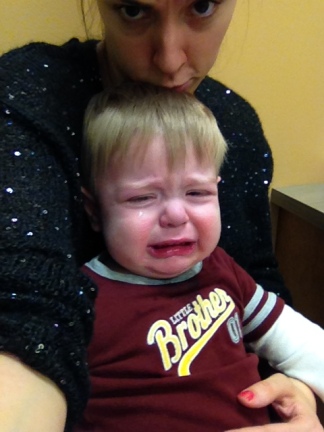








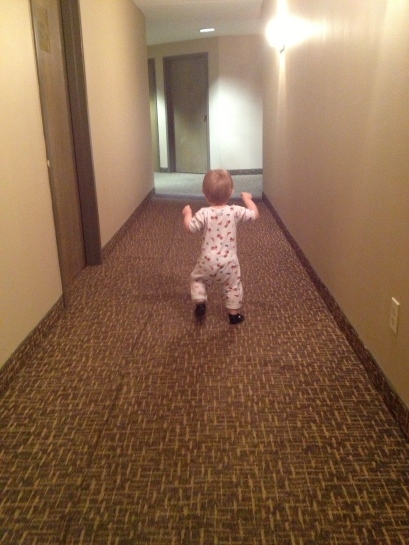
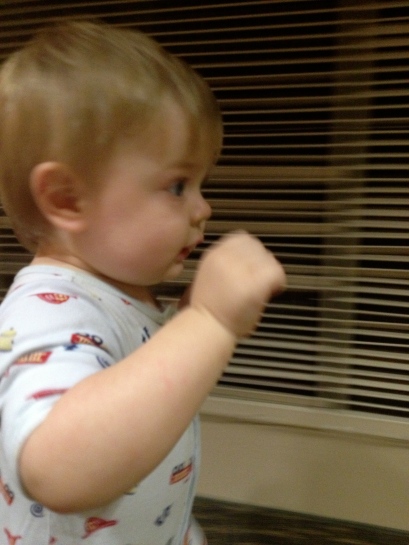











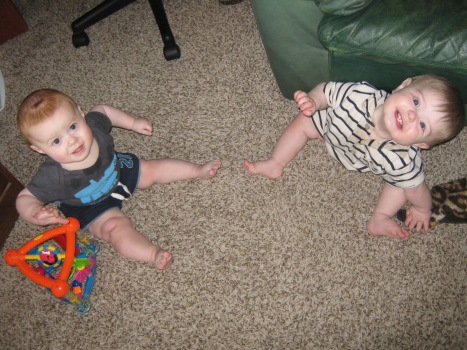 CHEEEEEEEEESE
CHEEEEEEEEESE
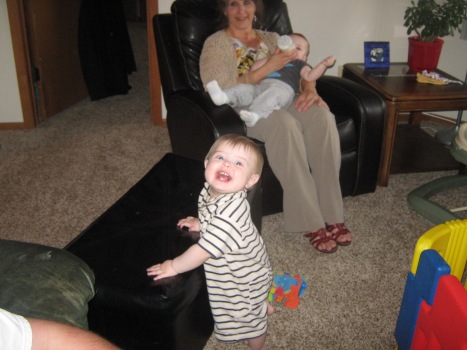
 CHEEEEEEEEEEEEEEEEEEEEEESE
CHEEEEEEEEEEEEEEEEEEEEEESE


 Hahaha. We are just kidding. But seriously, soon it will look like this outside again:
Hahaha. We are just kidding. But seriously, soon it will look like this outside again:



 5. Go read what the mom and dad of
5. Go read what the mom and dad of 





 2. My brother Dominic
2. My brother Dominic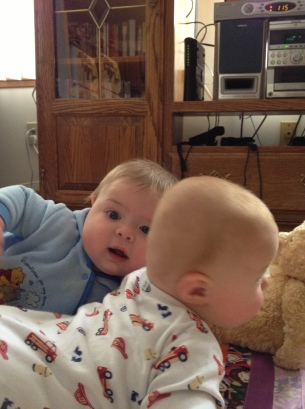

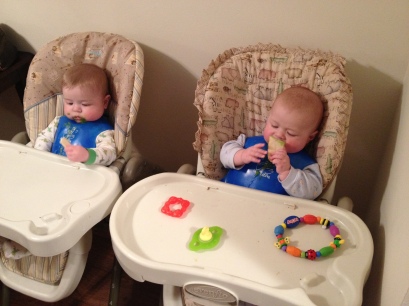



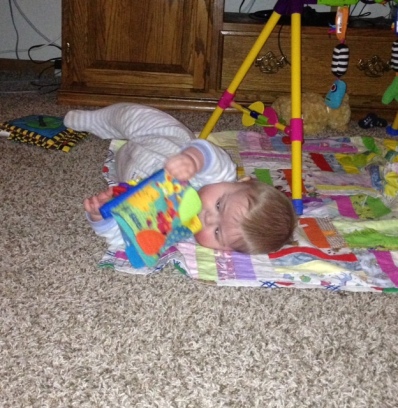
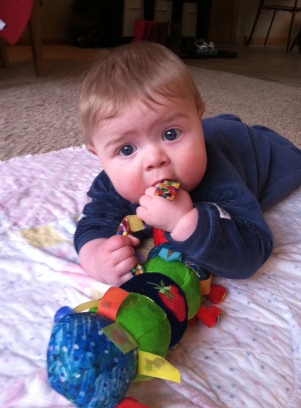
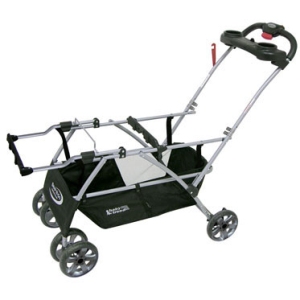
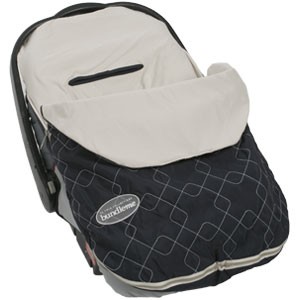
 Another thing I like to do is take a large binder clip and clip the top layer of the BundleMe to the sun shade on the car seats. This creates a warm little wind-resistant cocoon for each baby.
Another thing I like to do is take a large binder clip and clip the top layer of the BundleMe to the sun shade on the car seats. This creates a warm little wind-resistant cocoon for each baby.
 Cost: We got ours free from a friend (this is another item I saved from when Big Brother was a baby) but similar toys sell for about $20. You can pick these up secondhand for under $10.
Cost: We got ours free from a friend (this is another item I saved from when Big Brother was a baby) but similar toys sell for about $20. You can pick these up secondhand for under $10. Cost: These cost about $28 new. We got ours from the hospital where the babies were born when we went home with them.
Cost: These cost about $28 new. We got ours from the hospital where the babies were born when we went home with them. Cost: We got ours secondhand from a friend for free, but
Cost: We got ours secondhand from a friend for free, but  Cost: Giraffe was a gift from Auntie. But Dominic says it is priceless.
Cost: Giraffe was a gift from Auntie. But Dominic says it is priceless.